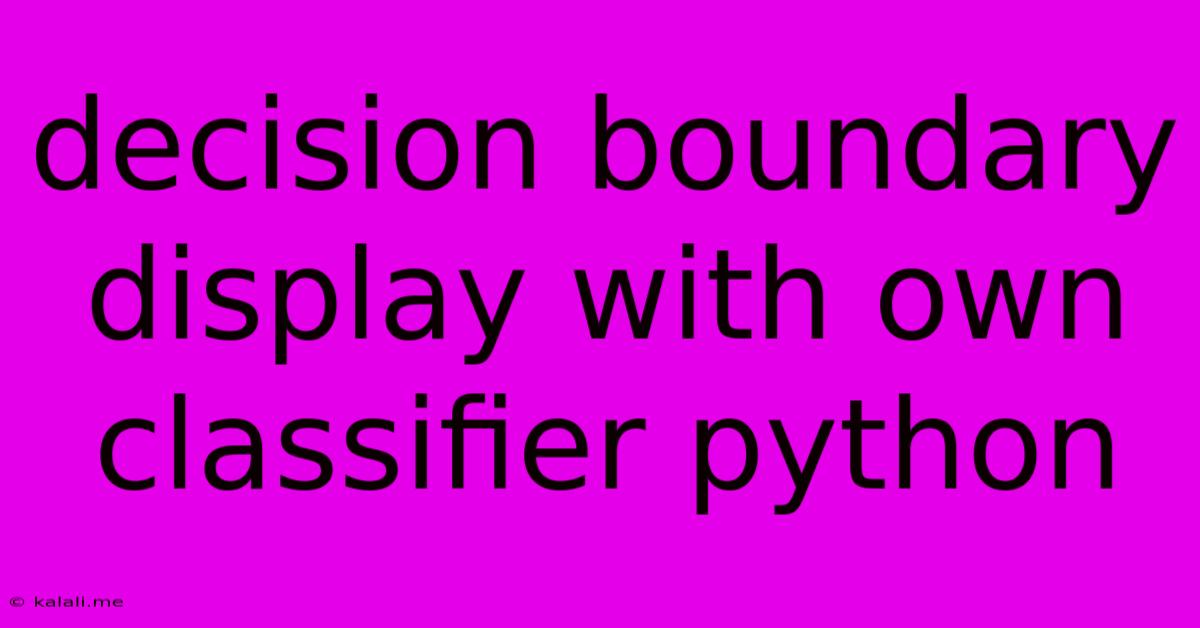Decision Boundary Display With Own Classifier Python
Kalali
Jun 05, 2025 · 3 min read

Table of Contents
Visualizing Decision Boundaries: A Python Guide for Custom Classifiers
Understanding how your classifier makes decisions is crucial for evaluating its performance and identifying areas for improvement. Visualizing the decision boundary provides a powerful way to achieve this, offering insights into the classifier's strengths and weaknesses. This article will guide you through creating visualizations of decision boundaries for your own custom classifiers in Python, focusing on clarity and understanding. We'll cover the fundamental concepts and provide practical code examples.
This article will cover: understanding decision boundaries, implementing visualization with Matplotlib, handling different classifier types, and interpreting the results for model improvement.
What are Decision Boundaries?
In machine learning classification, a decision boundary (also known as a decision surface) is a hyperplane that separates different classes in your feature space. It represents the regions where the classifier predicts one class versus another. For a simple two-feature dataset, the decision boundary is a line; for three features, it's a plane; and for higher dimensions, it's a hyperplane – difficult to visualize directly. Visualizing this boundary gives a clear picture of how your model partitions the feature space and makes predictions.
Visualizing Decision Boundaries with Matplotlib
The Python library Matplotlib provides the tools for creating these visualizations. The core idea is to create a grid of points covering your feature space, predict the class for each point using your classifier, and then color-code these points based on their predicted class. The boundary between different colors represents the decision boundary.
Let's illustrate with a simple example using a custom k-Nearest Neighbors classifier:
import numpy as np
import matplotlib.pyplot as plt
from sklearn.datasets import make_moons
# Generate sample data
X, y = make_moons(n_samples=100, noise=0.15, random_state=42)
# Custom k-NN classifier (simplified for illustration)
class KNN:
def __init__(self, k=3):
self.k = k
def fit(self, X, y):
self.X = X
self.y = y
def predict(self, X):
predictions = []
for x in X:
distances = np.sqrt(np.sum((self.X - x)**2, axis=1))
k_nearest_indices = np.argsort(distances)[:self.k]
k_nearest_labels = self.y[k_nearest_indices]
prediction = np.bincount(k_nearest_labels).argmax()
predictions.append(prediction)
return np.array(predictions)
# Initialize and train the classifier
knn = KNN(k=3)
knn.fit(X, y)
# Create meshgrid for plotting
x_min, x_max = X[:, 0].min() - 1, X[:, 0].max() + 1
y_min, y_max = X[:, 1].min() - 1, X[:, 1].max() + 1
xx, yy = np.meshgrid(np.arange(x_min, x_max, 0.01),
np.arange(y_min, y_max, 0.01))
# Predict on the meshgrid
Z = knn.predict(np.c_[xx.ravel(), yy.ravel()])
Z = Z.reshape(xx.shape)
# Plot the decision boundary
plt.contourf(xx, yy, Z, alpha=0.8)
plt.scatter(X[:, 0], X[:, 1], c=y, edgecolors='k')
plt.title('Decision Boundary of Custom k-NN Classifier')
plt.xlabel('Feature 1')
plt.ylabel('Feature 2')
plt.show()
This code generates a plot showing the decision boundary of our simple k-NN classifier on a synthetic dataset. The different colored regions represent the areas where the classifier predicts different classes.
Adapting for Different Classifier Types
This visualization technique can be applied to various classifiers. You simply need to replace the knn.predict call with the prediction function of your chosen classifier. Ensure your classifier's predict method accepts a NumPy array as input.
Interpreting the Results
By examining the decision boundary, you can gain several insights:
- Model Complexity: A highly irregular boundary suggests a complex model that might be overfitting.
- Class Separability: Clearly separated regions indicate good class separability; overlapping regions might point to limitations of the model or the need for feature engineering.
- Areas for Improvement: Regions with misclassified points highlight areas where the model struggles and might indicate a need for more data, feature engineering, or a different model altogether.
Remember to adapt the code and interpretation based on your specific dataset and classifier. Visualizing the decision boundary is a crucial step in understanding and improving your machine learning models. Experiment with different classifiers and datasets to solidify your understanding of this powerful visualization technique.
Latest Posts
Latest Posts
-
Does Greyhound Accept Prison Id Bracelets In Virginia
Jun 07, 2025
-
Why Did Eren Fight Alongside Zeke
Jun 07, 2025
-
How To Send Prompt To Chatgpt With A Query String
Jun 07, 2025
-
How To Find A Key Fob
Jun 07, 2025
-
What Does Language Agnostic Mean In Javascript
Jun 07, 2025
Related Post
Thank you for visiting our website which covers about Decision Boundary Display With Own Classifier Python . We hope the information provided has been useful to you. Feel free to contact us if you have any questions or need further assistance. See you next time and don't miss to bookmark.